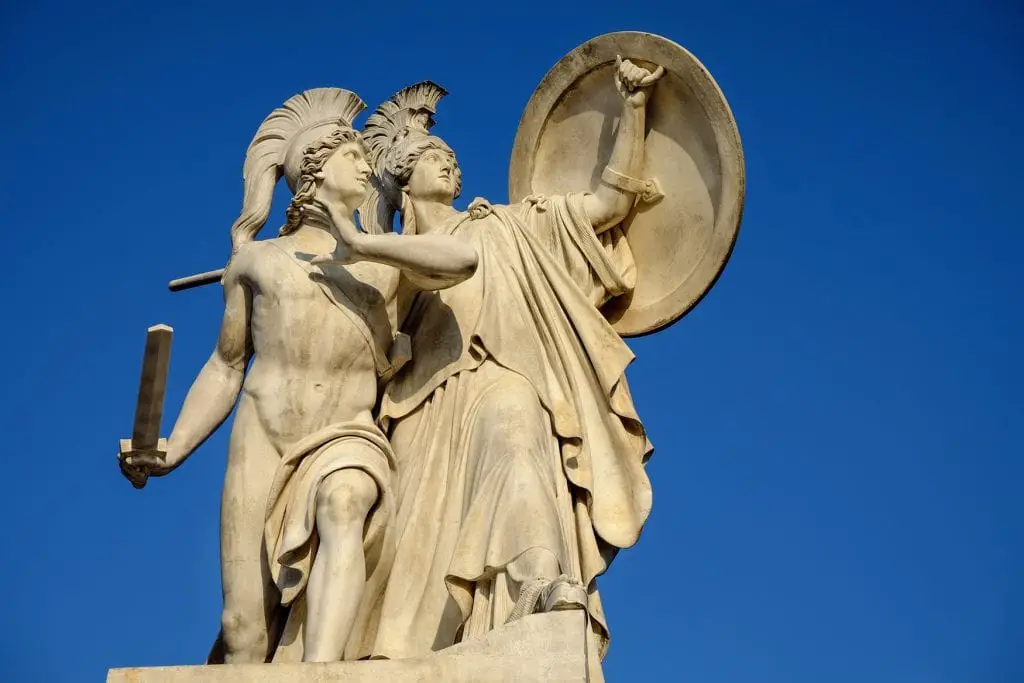
The two types of blue in Greek mythology
The Greek poet Homer, author of The Iliad and The Odyssey, distinguished two types of blue — kuaneos and glaukos. While goddess Athena had glaukopis eyes, the dark-blue waters of the sea were kuaneos. The Greek word glaukopis stood for the grey-blue or the luminous blue. Kuaneous was more suited for the dark shades of blue, often found in the deep waters of the sea and in the stormy, frightening sky. Glaukopis was for the light, brilliant and bright, while kuaneos for the deep, tinted and dark.
The myth of the blue Greek sky
Why is the sky blue? The story goes that one day Zeus, the Greek god of the sky, asked his daughter Athena to make a wish. The blue-eyed Athena, wrapped up in herself, wished that the world could see her beauty every single day. Zeus granted Athena’s wish by turning the sky in blue, the color of her beautiful eyes.
From unicorns to ancient horses and heroes — the symbolism of the blue eye
The unicorn — a wild, single-horned and horse-like animal — appears in Greek Mythology. The Greek historian and writer Ctesias described the unicorn as a mythical creature whose horn possessed healing powers. A notable feature of this monokerōs (single-horned) animal were its blue eyes.
When it comes to Alexander the Great, the greatest conquer of the Ancient World, history and myth intertwine. It is said that Bucephalus, Alexander’s legendary horse, was wall-eyed (had one blue eye). Alexander, too, reportedly had heterochromia — one of his eyes was brown, and the other one blue.

The blue symbolism of the peacock in Greek mythology
Hera, the Greek goddess of women and marriage (and a wife of Zeus) had a chariot pulled by her bellowed peacocks. The blue peacock feathers fit well in the iconography of Hera, as she was also known as the goddess of the sky and the stars.
When Zeus fell in love with a beautiful mortal Io, Hera appointed her hundred-eyed servant, Argus Panoptes, to guard Io and prevent Zeus from approaching her. Zeus tricked Argus into a sleep and killed him. To honor her faithful servant, Hera turned his hundred eyes into the eye-like patterns of the peacock.
In Ancient Greece, peacock ‘eyes’ were also compared to the ‘evil eye’. The Greek philosopher Plutarch considered the eyes as a source of malevolent energy rays that could harm others. He claimed that blue-eyed people were more apt at casting an evil eye. The evil eye could bring bad luck, illness or even death. Greeks even developed ‘xematiasma,’ a special ritual to cast away the effect of an evil eye.
The Greeks made a talisman called a ‘mati’ or ‘matiasma,’ to ward off an evil eye. The ‘mati’ is are made of blue colored glass and have the shape of a giant eye. This apotropaic charm is popular in Greece even today.
It was probably Alexander the Great who brought the first peacock from India to Greece. It is likely that he also brought to Greece the ‘evil eye’ charm somewhere from the East.

Blue as a symbol of metamorphosis — Greek gods and mortals who turned into blue flowers
Greek mythology is rich in stories of one’s metamorphosis into plants and flowers.
One of these myths involves Asteria, the Greek Titan goddess of innocence, whose name means ‘star-maiden’. The story goes that Zeus, enraged by the sights of men fighting one-another, sent a flood to put an end to the human race. Upon seeing the devastation, Asteria cried, and as soon as her tears reached the earth, they turned into beautiful blue aster flowers.
Another myth speaks of the origin of the blue poisonous aconite flower. The Greek hero Heracles was tasked to fetch Cerberus (Kerberos). Cerberus was a dreadful, three-headed dog, who guarded the gates of the underworld. At the place where the dripping spittle of Cerberus touched the earth, the first aconite flower appeared. It is also said that Medea tried to poison Theseus with a glass of aconite-laced wine.
Yet another Greek myth tells the story of Persephone, the Greek goddess of vegetation, who was abducted by Hades, the god of the Underworld. At the time of her abduction, she and her playmates gathered flowers for her bouquet. Since the blue iris was one of those spring meadow flowers in her bouquet, it became a symbol of her descent into the Underworld.
The legend says that the blue larkspur flower sprang from the blood of the Trojan hero Ajax. He and Odysseus competed to win Achilles armor as a recognition for their contribution in the Trojan war. Odysseus succeeded to convince the gods in his own merit and earned the armor. Ajax got so enraged, that he committed a suicide.
Finally, there is a Greek myth about the origin of the blue hyacinth flower. Hyacinthus was a good-looking Spartan prince. He was a lover of Apollo, the god of archery, art, healing and prophesy. One day, Apollo was teaching Hyacinthus the art of throwing a discus. Upon seeing this, Zephyros (the god of the wind) became jealous and blew the discus mightily, striking Hyacinthus in the head. Apollo lamented the death of Hyacinthus terribly. In his remembrance, he made his blood sprout into a blue hyacinth flower.

Blue as a symbol of the sky in Greek Mythology
Blue is the color of the sky. Many Greek gods and goddesses represented the blueness of Heaven and the sky. Among them, the most prominent were Ether, Uranus and Zeus.
Before the establishment of the twelve Olympian gods of the Greek pantheon, there were several primordial deities who ruled the elemental forces of nature.
Aether was a Greek primordial god and an archetype of the blue and pure ‘upper sky’. Ancient Greeks described the blue ether as ‘the stuff’ of which Heaven is made. Ether is also the higher quality of air, which Gods breathe.
Uranus, the ‘Father Sky,’ was the primordial god of the sky. He was the elemental deity of the rain, also called ‘the lord of rains’.
Zeus was the king of all gods of Mount Olympus. Holding a lightning bolt in his hand, he acted as a sovereign of Heaven. He was the supreme god of the sky, destiny and law. Whenever he felt sad and cried, he made it rain on earth.
Blue as a symbol of the sea and freshwater in Greek Mythology
Blue is also the color of all earth waters. Greek mythology is rich in gods, Titans and nymphs associated with the blueness of the rivers and the sea.
Among the pre-Olympian divinities of the sea, the most powerful were Pontus (the ancient, primordial god of the sea), and Thalassa (the primeval spirit of the sea). Greek Mythology also mentions Nereus (the shape-shifting ‘Old Man of the Sea’) and Thaumas (the ‘Wonder of the Sea’).
Poseidon, together with his brothers Zeus and Hades, formed a mighty triad. Namely, why Zeus was the chief God of the Sky, and Hades god of the Underworld, Poseidon ruled the Sea. Holding a trident or a fish spear in his hand, as a symbol of the sea, Poseidon is associated with the deep blue color of the sea. This “Lord of the Sea’ was a powerful protector of the seafarers.
Oceanus was the Greek Titan god, sometimes revered as the primeval father of all Greek gods. He was the source of all rivers and oceans, a ‘genesis of all’. Tethys was the primordial mother of 6,000 water deities.
Oceanus and Tethys had 3,000 sons, all river gods. They were known as Potamoi, and each was a god of a different river. Oceanus and Tethys also had 3,000 daughters, known as Oceanids. Most of them were nymphs or water deities, and they personified springs. The great system of Greek divinities also includes the Naiads, daughters of Potamoi. The Naiads were female water-spirits, responsible for the wells, streams and all fresh water bodies.
Blue as a symbol of beauty born out of the blue sea
The name of Aphrodite, the Greek goddess of love, beauty and fertility means ‘sea-foam’. The goddess was born when Cronus castrated his father, Uranus, and threw his genitals into the sea. Aphrodite is often considered a daughter of the sea. She is often seen as personification of passion, pleasure and desire.
Blue as a symbol of the dangers of the deep sea — the spellbinding song of the sirens
When speaking of Greek Mythology in the context of the deep blue sea, it is impossible not to mention the sirens, those dangerous sea creatures who lured sailors with their enchanting singing. The half-woman, half-bird sirens were such hypnotic creatures, that they caused many shipwrecks and deaths of men in open sea. Sirens are not to be mistaken for mermaids, who appeared later, in the writings of Byzantine Greece.
The sirens were daughters of Phorcys and Achelous. Phorcys was a primordial sea god, a merman with a tail of a fish, spiky red skin and crab-like claws. Achelous was the god of the largest Greek river. Phorcys and Achelous fathered dreadful sirens with Calliope, Melpomene and Terpsichore, the three Muses or goddesses of inspiration.


